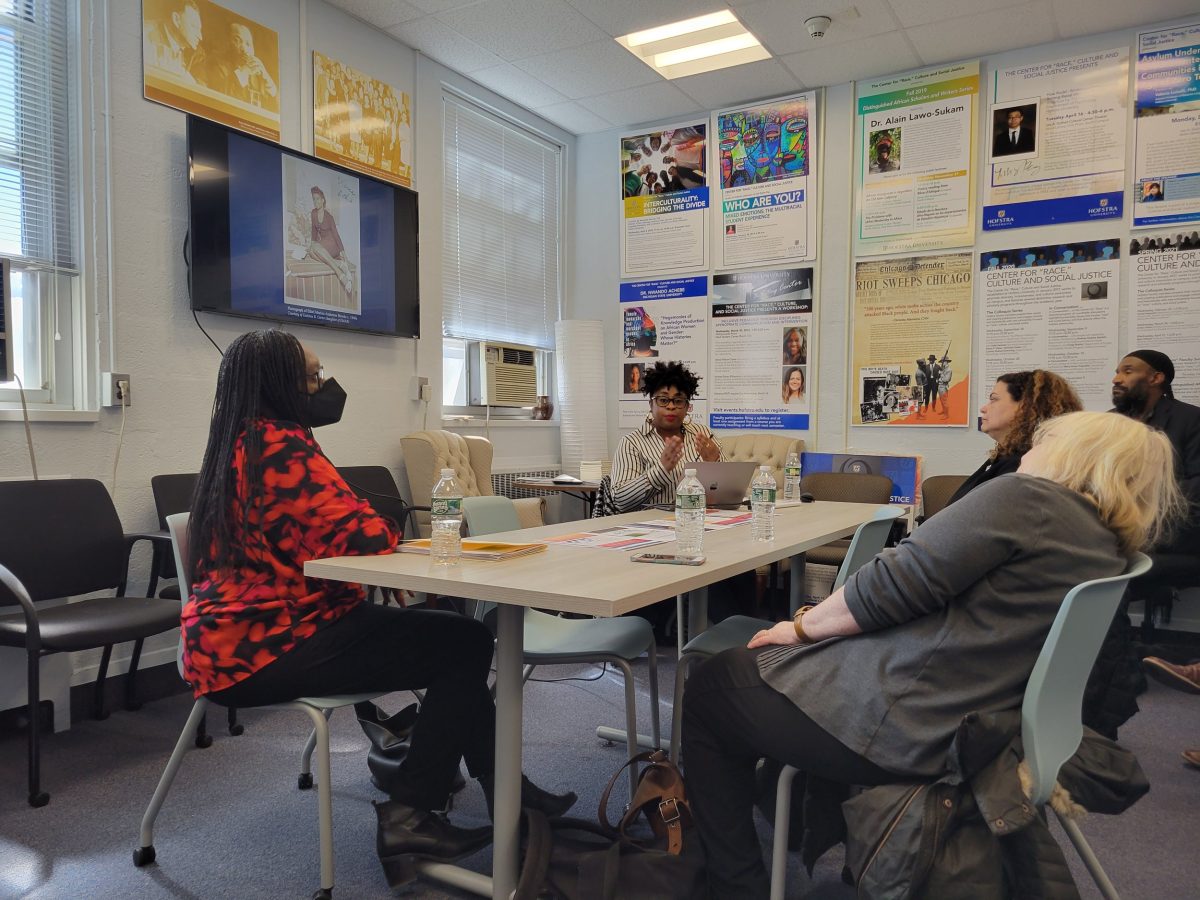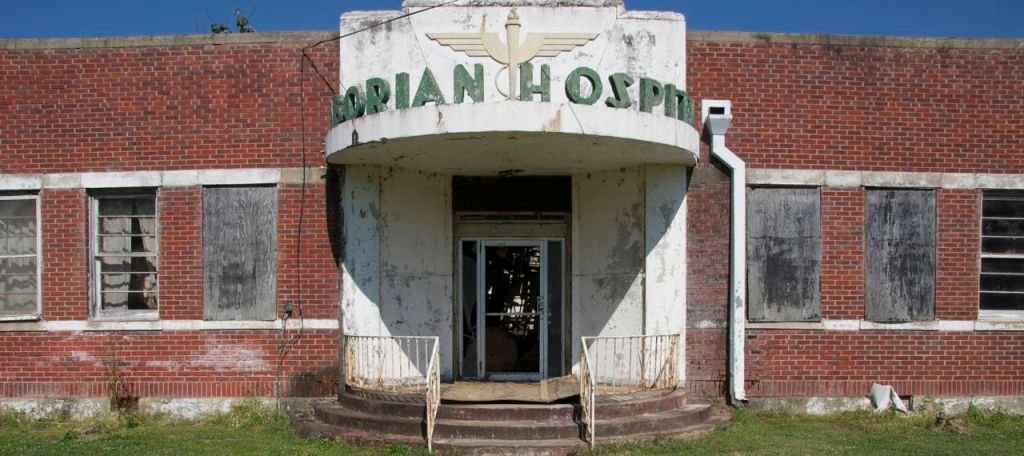Katrina Sims discusses the history of the International Order of Twelve Knights and Daughters of Tabor. // Moriah Sukhal / The Hofstra Chronicle.
On Wednesday, March 15, the Center for “Race,” Culture and Social Justice hosted its monthly Colloquia Series. This event featured a conversation with Katrina Sims, assistant professor of history and a faculty-in-residence at Hofstra University. Sims discussed the gender and class dynamics of the Black health movement in the Mississippi Delta during the mid-20th century.
Sim’s discussion, “The Cotton Field was Not the Place for Her,” explored the history of the Taborian Hospital located in Mound Bayou, Mississippi, and its role within the historical context of the Black health movement. According to Sims, the Taborian Hospital was one of the first hospitals in the Mississippi Delta to introduce a practical nurse training program in 1941. The program provided economic opportunities for Black women and “introduced a health politic that included access to medical and nonmedical care that was individualized, dignified, modern and uplifting,” said Sims.
Throughout her conversation, Sims worked to “rescue Black working-class women nurses from invisibility and place them at the center of the modern Black health movement” by presenting the narrative experiences of Black women.
Sims began by recounting the experiences of Ethel Marion Anderson Brooks, a Black woman who sharecropped with her family in the Mississippi Delta. At the age of 15, Brooks declared that “the cotton field was not the place for her.”
Brooks first heard of the prospect of working as a nurse “with the announcement that the International Order of Twelve Knights and Daughters of Tabor would fund a hospital and that they were seeking young women nurses,” Sims said.
The organization’s new focus on health care was introduced in 1925 by Perry Monroe Smith. Sims explained that Smith was faced with the predicament of either taking his sick son on a two-hour journey from Mount Bayu to Yazim City to the only Black hospital – the Afro American Hospital – or going to Marigold Hospital.
Although Marigold was a closer hospital to Smith, he had to “suffer the indignity of walking through the back door [and] waiting for all the white patients to be treated while his son was sitting in agony,” Sims said.
Because of this, when Smith was elected International Chief Grand Mentor in 1937, he decided that the Knights and Daughters of Tabor would assume the healthcare mission.
“On Feb. 13, 1942, the Taborian Hospital opened, and it treated primarily prenatal and postnatal women,” Sims said.
Brooks and other African American working-class women at that time “wanted to align themselves with the Knights and Daughters of Tabor in part because they recognized the organization was addressing a major issue, which was the access to medical care, but also there was an economic incentive,” Sims said. “These women were able to have some level of self-determination and some say over their lives.”
The Taborian Hospital’s legitimacy was threatened in 1949 due to the professionalization movement, which demanded that Black working class women redirect their already meager family economic resources to enroll in state sanctioned nursing programs. // Photo courtesy of Suzassippi.
Upon the opening of the Taborian Hospital, Smith employed Katherine Dandridge. According to Sims, Dandridge graduated from Mahary Medical College and was educated in curriculum development concerning medical care. She attended the hospital in an advisory capacity and became “the first women anesthetist in the history of our nation at this moment in 1941,” Sims said.
Along with Dandrige, Nettie Perkins, the supervisor of nursing from 1946 to 1955, offered working-class Black women “who have no familiarity, for the most part, with health care principles, a world-class education,” Sims said.
“What is noteworthy of these two women,” she said, “[is that under] their leadership [and] instruction, it is this informal nursing program that becomes the first in the state in terms of vocational practices. However, while these women are being trained by some of the most premier educators, because of their economic status, they are unable to get the credentials necessary that would allow them to have the pay that would complement their work.”
One example of this is Annyce Perkins Campbell, who, despite being a registered nurse, “never earned more than $640 a month in her capacity as the head of obstetrics,” Sims said. “[Campbell] acknowledged that that was a necessary part of her work. She understood that in order for the hospital to stay open and treat predominantly poor patients, she needed to accept her relatively lower pay.”
Sims noted that when Mississippi began to embrace licensing requirements for practical nursing, it posed a credentialing problem for the Taborian Hospital. While the state argued that the conditions were emplaced to “increase the prestige of nursing and improve quality,” Sims countered that it “really acted as an erection of a barrier because women who could not go to institutions that the state was accrediting … They would not be able to access that license, thus, not be able to work.”
“There is an effort to remove Black women from the health care space,” Sims said.
She argues that “it is intentional and an extension of the anti-Black policies and laws that emerge during the progressive era.”
“When the state needed Black labor in the health care space, they were able to acknowledge the legitimacy of the program without accrediting [it],” Sims said. She explained that in the 1960s, Mississippi experienced a nursing shortage. While the labor of Black nurses was utilized, the Taborian Hospital trained practical nurses without state funding.
The Taborian Hospital is noteworthy for being an independent organization that never received state or federal funding. As Campbell explained to Sims, “it’s the product of the pennies, nickels, dimes and quarters of the Black community. It’s the fraternal women who are out doing the fundraising, and it is the nurses who are providing the medical and nonmedical care.”
Students who attended the event viewed the history of the Taborian Hospital as noteworthy.
Maria Moreno Suarez, a junior Latin American and Caribbean studies major, was fond of Sims’ discussion as she reflected on how the history of the state’s negligence in providing the Taborian Hospital credentials is a trend that is also prominent in Latin American countries.
“You see a lot of anti-Black, anti-Afro American or colorism in general in [Latin American countries],” Suarez said. “So being able to see that this [trend of withholding credentials] is not only in Latin American [or] Caribbean countries and that there are laws emplaced in America that can be placed into perspectives of these countries provides me with a basis for learning about [the trend] more.”
“I didn’t know the Taborian Hospital existed until this discussion,” said Jasmine Sellars, a junior journalism major. She reflected on the lack of media coverage of the Taborian Hospital.
“As a journalism major, I have a responsibility to tell the news, and it was definitely news to me,” Sellars said. “I’m not sure if they had journalists who were covering the anomaly that there’s a successful Black hospital taking care of patients.”
The work of Dandridge, Perkins and Black working-class women of this time is fundamental to the Black health movement, according to Sims.
“So much of the conversation around the Black health movement centers men, the physicians, for the most part,” Sims said. “They’ve been elevated in terms of their contributions, and it is these women who are largely responsible for educating the personnel who are handling the day-to-day matters. So, I think it is important we acknowledge them and their contributions.”









